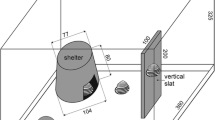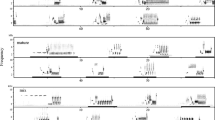Abstract
Song thrushes fed on populations of bread-stuffedCepaea shells. The results indicate that experience influences the selective behaviour of thrushes for both shell colour and shell size. Such behaviour could lead to frequency dependent selection in natural populations. Within the ranges of size and colour offered, thrushes learned from a colour rather than a size experience when both were varied simultaneously.
Similar content being viewed by others
References
Allen, J. A. (1973). Apostatic selection—the response of wild passerines to artificial prey. Ph.D. thesis, University of Edinburgh, U.K.
Arnold, R. W. (1970). A comparison of populations of the polymorphic land snailCepaea nemoralis (L.) living in a lowland district in France with those in a similar district in England.Genetics 64: 589–604.
Bantock, C. R. &J. A. Bayley (1973). Visual selection for shell size inCepaea.J. Anim. Ecol. 42: 247–261.
Bantock, C. R. &P. H. Harvey (1974). Colour polymorphisms and selective predation experiments.J. Biol. Ed. (in press).
Cain, A. J. &P. M. Shepherd (1954). Natural selection inCepaea.Genetics 39: 89–116.
Carter, M. A. (1967). Selection in mixed colonies ofCepaea nemoralis andCepaea hortensis.Heredity 22: 117–139.
Clarke, B. C. (1962a). Balanced polymorphism and diversity of sympatric species. In Taxonomy and Geography (ed. D. Nichols); 47–70. Systematics Association publication no. 4.
Clarke, B. C. (1962b). Natural selection in mixed populations of two polymorphic snails.Heredity 17: 319–345.
Clarke, B. C. (1969). The evidence for apostatic selection.Heredity 24: 347–352.
Croze, H. (1970). Searching image in carrion crows.Z. Tierpsychol 5: 1–85.
Davies, P. W. &D. W. Snow (1965). Territory and food in the song thrush.Br. Birds 58: 161–175.
Harvey, P. H., C. Jordan &J. A. Allen (1974). Selection behaviour by wild blackbirds at high prey densities.Heredity 33: 401–404.
Tinbergen, L. (1960). The natural control of insects in pine woods. I. Factors influencing the intensity of predation by song birds.Archs. néerl. Zool. 13: 265–343.
Williamson, M. (1972). The analysis of biological populations. London: Arnold.
Author information
Authors and Affiliations
Rights and permissions
About this article
Cite this article
Harvey, P.H., Birley, N. & Blackstock, T.H. The effect of experience on the selective behaviour of song thrushes feeding on artificial populations ofCepaea (held). Genetica 45, 211–216 (1975). https://doi.org/10.1007/BF01517197
Received:
Accepted:
Issue Date:
DOI: https://doi.org/10.1007/BF01517197




